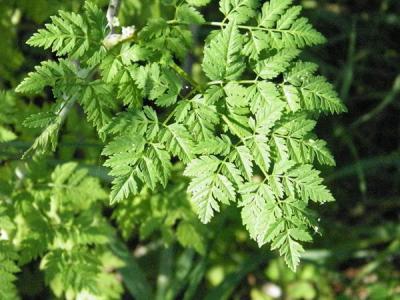By Angie Peltier

Driving down any Western Illinois road this spring one can't help but notice just how many very tall weeds there are growing in field edges and along fence rows. According to University of Illinois USDA Weed Ecologist Dr. Adam Davis, every weed species has specific germination cues, or moisture and temperature fluctuations required for seeds to germinate and seeds of biennial plants to survive the Illinois winter. Two weeds have been very abundant this year: poison hemlock and wild parsnip. Both plants are important to be able to identify as they can negatively affect human and/or livestock health.
Poison Hemlock (Conium maculatum). Poison hemlock is a member of the carrot family which becomes quite apparent when examining its leaves (Figure). This is where the above-ground similarity ends as poison hemlock forms small white flowers, is able to grow up to 7 feet tall and can actually form dense shrubs when in high densities (Figures). When ingested, this plant is toxic to animals, including humans, pets and livestock. According to the University of Missouri Extension's Plants Poisonous to Livestock publication, here are the key points to know about poison hemlock:
- "Key descriptive characteristics: This biennial has smooth, purple-spotted stems that are hollow. The leaves are pinnately compound, highly divided with very small leaflets giving the plant a fernlike appearance. The white flowers occur in umbels (umbrella-like) and closely resemble Queen Ann's Lace, a close relative.
- Habitat: Fields, pastures, fence rows, waste ground and rights-of-way.
- Poisonous part: All parts contain the toxic alkaloid, coniine and others.
- Symptoms: Salivation, vomiting, diarrhea, weakness, paralysis, nervousness, trembling, dilation of pupils, weak pulse, convulsions and coma."
A University of Illinois publication called Plants that Cause Skin Irritation indicates that although poison hemlock is typically known for poisoning through ingestion, the plant's natural oils can be absorbed through the skin to cause irritation.
This University of California Extension document details multiple poison hemlock management options. As always, be sure to follow all herbicide label guidelines and grazing restrictions.
Wild Parsnip (Pastinaca sativa L.). Wild parsnip is a very pretty plant with large umbrella-shaped structures (umbels) that hold small, yellow-green flowers (Figure). According to the University of Illinois Plants That Cause Skin Irritation publication,
"The stem of wild parsnip is somewhat hairy, grooved, and 2 to 5 feet tall. Leaves are coarse, with saw-toothed edges. Flowers are yellow and arranged in an umbrella shape similar to other members of the Carrot family. If the juice from broken stalks, leaves or flowers contacts your skin and then is exposed to sunlight, a skin rash can result 24-48 hours later. Wild parsnip is easier to identify from the other photo dermatitis causing plants because of the yellow flower color. Distribution: Throughout Illinois, however, more common in the northern 2/3 of the state. Habitat: Fields, roadsides, pastures, prairie."
Source:illinois.edu